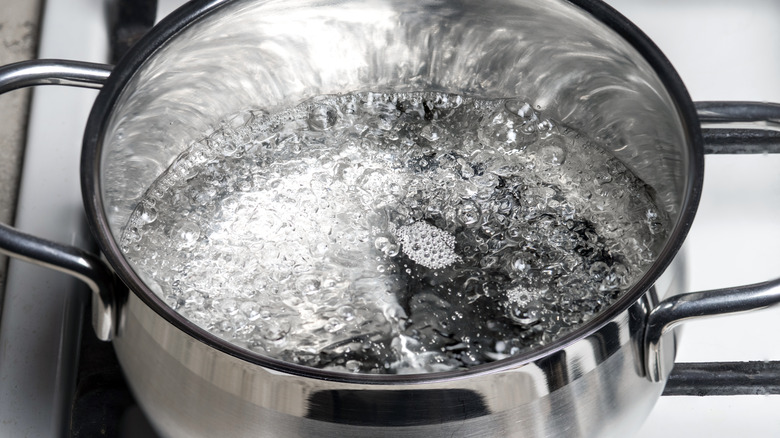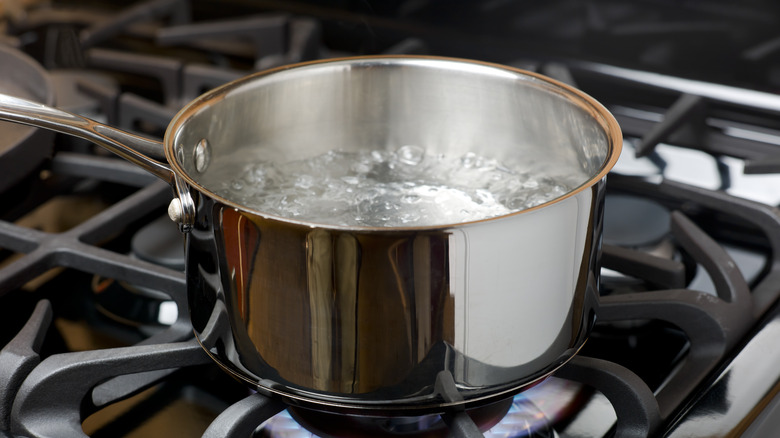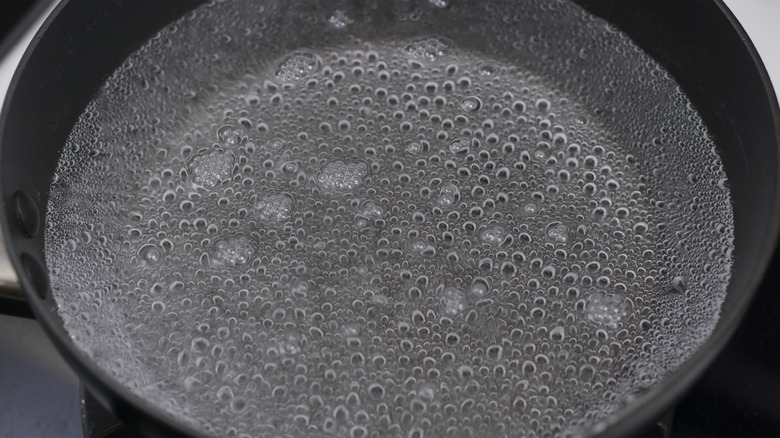How To Speed Up Boiling Water On The Stove With Just A Pan
Boiling water quickly is important when balancing a speedy and delicate cooking session, when separate food and ingredients are quickly cooling off, or simply when you're super hungry and can't wait anymore. Luckily, there exists more than one way to speed up the rate at which water reaches the point it turns into steam. Salt is supposedly the go-to method of creating a faster boiling rate, but this isn't exactly foolproof. Besides, there may be situations when you don't want your water to taste like the sea, such as when making a hot cup of tea. In these instances, there are simpler, more effective measures for a faster boil.
The most important rule of thumb is to remember that the more surface area water can sit in, the faster it heats up. That's because more of the water is touching the metal that heats up from the flame underneath the pot, in contrast to a more vertically shaped container that only exposes a fraction of the water inside to the direct heat. For this reason, it may actually be easier to heat up water with a wider pan than a traditional pot. Placing a lid on top of the vessel will also speed up the boiling since the hot steam gets trapped inside and helps to heat up the rest of the water. So ditch the saucepan and use the sauté pan with a lid. When it's boiled, transfer the contents to your pot, and Bob's your uncle.
What happens when water boils
Boiling water is one of the most intuitive, commonplace activities that take place in a kitchen, but the chemistry behind this reaction is a remarkable example of the complex interactions that take place on a subatomic level. H20 molecules are, in fact, strongly bonded together, and on a relative scale compared to other compounds, water actually has a high boiling point. Simply put, hydrogen and oxygen molecules are more attracted to each other and are thus harder to break apart. That's also why it's relatively easy to freeze water molecules, and why the more unstable bonds of alcohol molecules (specifically ethanol), messy relationships as they are, boil and freeze at lower temperatures.
Applying more heat energy to H20 encourages the molecules to speed up their movement, helping to break their chains. No longer committed to a relationship and free to explore the world, the boiled water can now exist in a free-moving vapor state known as steam. Atmospheric pressure also affects the boiling point of water because air density squeezes molecules closer together. The lower the pressure, the more room the water has to escape into the air. As a result, water boils faster in higher altitudes, which is something to keep in mind if you ever find yourself cooking in Mexico City, Denver, or Bogotá.
Saying no to salt
Based on this scientific reasoning, a wider surface area and a more enclosed space makes complete sense. The more heat water is exposed to — whether through direct contact with hot metal or steam — the faster the bonds will sever. Pressure cookers, in which all the evaporated steam is contained inside, are proof of the effectiveness of putting a lid on top of a pot of boiling water.
Not only are these methods the simplest way of boiling water, they're also the most effective. Adding salt to water may boost hydration, but doing so to make it heat up faster is a myth — although it can help in cutting down the time it takes for something to boil rather than actually lowering the boiling point, but only marginally. On the contrary, the additional salt molecules make it more difficult for the water molecules to shake each other off, so salt raises the boiling point. This means that once saltwater reaches a boil, pasta and anything else placed inside will cook faster than it would in regular water since the temperature is higher. In this way, salting water is more useful as a way to precisely cook ingredients than it is a shortcut. To boil faster, all you need is a wider pot and a lid.



